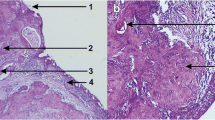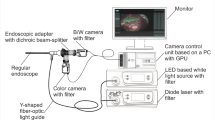Abstract
Differences in autofluorescence between normal and malignant tissues offer new possibilities for detecting and localizing early laryngeal carcinomas. In the present study imaging was performed using a specially designed device that exploits differences in fluorescent properties of normal and cancerous tissues without photodynamic drugs. Fluorescence was induced by a helium-cadmium laser, captured by an image-intensified camera and displayed on a video monitor after previous computerization. Thirty patients were evaluated, of whom 18 had suspect malignancies. Laryngoscopic appearances during standard microlaryngoscopy were compared to fluorescence images, computerized fluorescence intensities and histopathological findings. The experience from this study shows that autofluorescence laryngoscopy may be a useful complementary method for detecting laryngeal malignancies.
Similar content being viewed by others
References
Ghisla S, Massey V, Lhotse JM, Mayhew SG (1975) Fluorescence characteristics of reduced flavins and flavoproteins. In: Yagi K (ed) Reactivity of flavins. University of Tokyo Press, Tokyo, pp 15–24
Harries ML, Lam S, MacAulay C, Qu J, Palčič B (1995) Diagnostic imaging of the larynx: autofluorescence of laryngeal tumors using the helium-cadmium laser. J Laryngol Otol 109: 108–110
Hung J, Lam S, LeRiche JC (1991) Autofluorescence of normal and malignant bronchial tissue. Lasers Surg Med 11: 99–105
Kambič V, Gale N (1995) Epithelial hyperplastic lesions of the larynx. Elsevier, Amsterdam, p 108
Kleinsasser O (1988) Tumors of the larynx and hypopharynx. Thieme, Stuttgart, pp 128–130
Lam S, Hung J, Palcic B (1991) Mechanism of detection of early lung cancer by ratio fluorometry. Lasers Life Sci 4: 67–73
Lam S, MacAulay C, Hung J (1993) Detection of dysplasia and carcinoma in situ using a lung imaging fluorescence endoscope (LIFE) device. J Thorac Cardiovasc Surg 105: 1035–1040
Leonard JR, Beck WL (1971) Hematophorphyrin fluorescence: an aid in diagnosis of malignant neoplasms. Laryngoscope 81: 365–372
Palčič B, Lam S, Hung J, MacAulay C (1991) Detection and localisation of early lung cancer by imaging techniques. Chest 99:742–743
Qu J, MacAulay C, Lam S, Palčič B (1994) Optical properties of normal and carcinoma bronchial tissue. Appl Optics 33: 7397–7405
Russo C, Zibordi F (1966) Il test della fluorescenza da tetraciclina nei carcinomi laringei. Ann Laringol 65: 747–753
Sutro CJ, Burman MC (1933) Examination of pathological tissues by altered ultraviolet radiation. Arch Pathol 16: 346–349
Author information
Authors and Affiliations
Rights and permissions
About this article
Cite this article
Žargi, M., Šmid, L., Fajdiga, I. et al. Detection and localization of early laryngeal cancer with laser-induced fluorescence: Preliminary report. Eur Arch Otorhinolaryngol 254 (Suppl 1), S113–S116 (1997). https://doi.org/10.1007/BF02439739
Issue Date:
DOI: https://doi.org/10.1007/BF02439739




